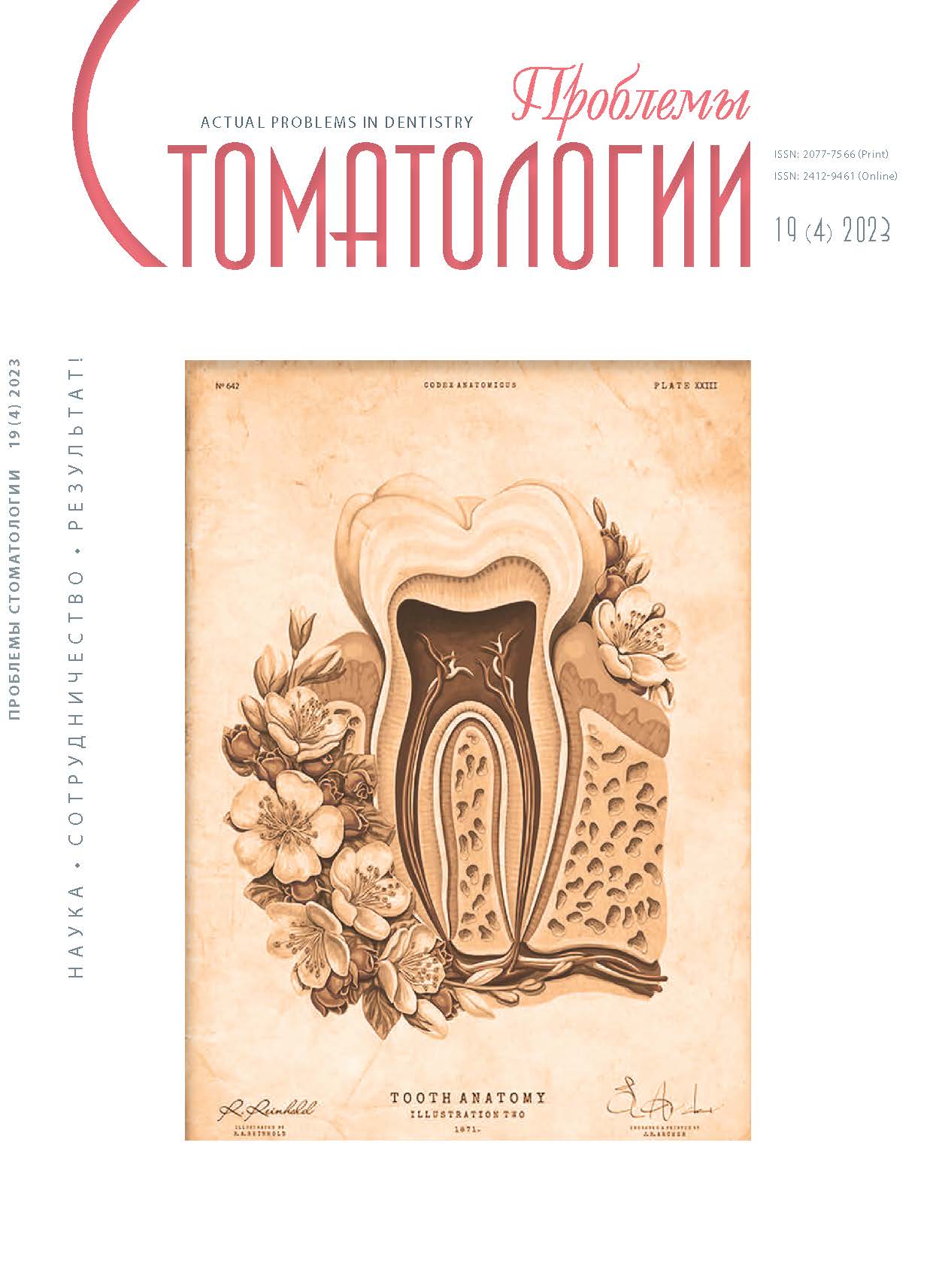Moscow, Moscow, Russian Federation
Moscow, Moscow, Russian Federation
Moscow, Moscow, Russian Federation
Moscow, Moscow, Russian Federation
UDC 616.31
Aim: to evaluate the characteristics of glazed and polished surface during hydrothermal aging using different types of zirconium dioxide. Materials and Methods. The same standardized samples from different types of zirconium dioxide with a diameter of 10 mm and a height of 1 mm were used for all experiments. These types included Katana (Kuraray Noritake Dental, Tokyo, Japan) HTML (control) UTML, STML, and ZirCAD Prime (Ivoclar Vivadent). Atomic force microscopy (AFM) was used to measure the roughness and to visualize the surface morphology of the samples. The Bruker Innova instrument was used as an atomic force microscope. Image acquisition was carried out in semi-contact mode. The probe sensor was TESP-V2 with a triangular-shaped probe and a tip radius of 7 nm. The scanning area was 50 x 50 μm. Frequency 0.5 Hz. The study of roughness was reduced to the processing of AFM image data. For this purpose, three arbitrary sections were made in the height map channel and the necessary roughness parameters Ra, Rz were calculated using software. Results. There was an increase in roughness during artificial aging of the control group of glazed surface, Prime group of polished surface, and Prime group of glazed surface. There is a decrease of roughness in the process of artificial aging of the control group of glazed surface, for STML and UTML groups of both glazed and polished surface. In the case of samples of group "polishing" it is possible to observe that roughness is formed by traces of abrasive material. From the results of the study of roughness it can be noted that for the samples of the group "Glaze" roughness is formed mainly by traces of brush or other tools used in the process of glaze application Conclusion. Artificial aging affects the roughness of the glazed and polished surface of zirconium dioxide with cubic phase predominance depending on the amount of yttrium content.
zirconium dioxide, roughness, artificial aging, atomic force microscopy, glaze
1. Denry I., Kelly J.R. State of the art of zirconia for dental applications // Dent Mater. - 2008;24(3):299-307. doi:https://doi.org/10.1016/j.dental.2007.05.007.
2. Kongkiatkamon S., Rokaya D., Kengtanyakich S., Peampring C. Current classification of zirconia in dentistry: an updated review // PeerJ. - 2023;11:e15669. doi:https://doi.org/10.7717/peerj.15669.
3. Lima J.C., Tribst J.P., Anami L.C., de Melo R.M., Moura D.M., Souza R.O., Bottino M.A. Long-term fracture load of all-ceramic crowns: Effects of veneering ceramic thickness, application techniques, and cooling protocol // J Clin Exp Dent. - 2020;12(11):e1078-e1085. doi:https://doi.org/10.4317/jced.57352.
4. Dal Piva A.M.O., Tribst J.P.M., Werner A., Anami L.C., Bottino M.A., Kleverlaan C.J. Three-body wear effect on different CAD/CAM ceramics staining durability // J Mech Behav Biomed Mater. - 2020;103:103579. doi:https://doi.org/10.1016/j.jmbbm.2019.103579.
5. Zhu Y., Liu K., Deng J., Ye J., Ai F., Ouyang H., Wu T., Jia J., Cheng X., Wang X. 3D printed zirconia ceramic hip joint with precise structure and broad-spectrum antibacterial properties // Int J Nanomedicine. - 2019;14:5977-5987. doi:https://doi.org/10.2147/IJN.S202457.
6. Moreira Bastos Campos T., Marques de Melo Marinho R., de Oliveira Pinto Ribeiro A., Larissa do Amaral Montanheiro T., Carolina da Silva A., Thim G.P. Microstructure and mechanical properties of fully sintered zirconia glazed with an experimental glass // J Mech Behav Biomed Mater. - 2021;113:104093. doi:https://doi.org/10.1016/j.jmbbm.2020.104093.
7. Jitwirachot K., Rungsiyakull P., Holloway J.A., Jia-Mahasap W. Wear Behavior of Different Generations of Zirconia: Present Literature // Int J Dent. - 2022;2022:9341616. doi:https://doi.org/10.1155/2022/9341616.
8. Souza L.F.B., Soares P.M., Chiapinotto G.F., Ribeiro V.F., Daudt N.F., Valandro L.F., Pereira G.K.R. Effect of pigmentation techniques on the fatigue mechanical behavior of a translucent zirconia for monolithic restorations // J Mech Behav Biomed Mater. - 2022;134:105362. doi:https://doi.org/10.1016/j.jmbbm.2022.105362.
9. Hatanaka G.R., Polli G.S., Adabo G.L. The mechanical behavior of high-translucent monolithic zirconia after adjustment and finishing procedures and artificial aging // J Prosthet Dent. - 2020;123(2):330-337. doi:https://doi.org/10.1016/j.prosdent.2018.12.013.
10. Talekar A., Chaudhari G., Mallineni S.K., Kothare S., Patil A., Musale P., Chunawala Y., Choubey S. Ex Vivo Assessment of Natural Teeth Wear against Zirconia and Novel Glass-Fiber-Reinforced Composite Crowns in Primary Teeth by a Three-Dimensional Assessment Method // Int J Dent. - 2021;2021:9670982. doi:https://doi.org/10.1155/2021/9670982.
11. Almohefer S., Moazzez R., Bartlett D. Comparison of metrology created by profilometry and digital microscopy on polished dentine in an erosion/abrasion model // J Dent. - 2021;114:103831. doi:https://doi.org/10.1016/j.jdent.2021.103831.
12. Peters R.D., Noble S.D. Characterization of leaf surface phenotypes based on light interaction // Plant Methods. - 2023;19(1):26. doi:https://doi.org/10.1186/s13007-023-01004-2.
13. Hafezeqoran A., Sabanik P., Koodaryan R., Ghalili K.M. Effect of sintering speed, aging processes, and different surface treatments on the optical and surface properties of monolithic zirconia restorations // J Prosthet Dent. - 2023;130(6):917-926. doi:https://doi.org/10.1016/j.prosdent.2021.12.005.
14. Peampring C., Kengtanyakich S. Surface Roughness and Translucency of Various Translucent Zirconia Ceramics after Hydrothermal Aging // Eur J Dent. - 2022;16(4):761-767. doi:https://doi.org/10.1055/s-0041-1736415.
15. Gvetadze R.Sh., D'yakonenko E.E., Lebedenko I.Yu. Issledovaniya stareniya, ustalosti i degradacii s cel'yu povysheniya nadezhnosti stomatologicheskoy cirkonovoy keramiki. Obzor statey v mirovyh zhurnalah. Stomatologiya. 2016;95(6):51-60. [R.Sh. Gvetadze, E.E. Dyakonenko, I.Yu. Lebedenko. Aging, fatigue and degradation studies to improve the reliability of dental zircon ceramics. Review of articles in world journals. Dentistry. 2016;95(6):51-60. (In Russ.)]. DOI:https://doi.org/10.17116/stomat201695651-60



















